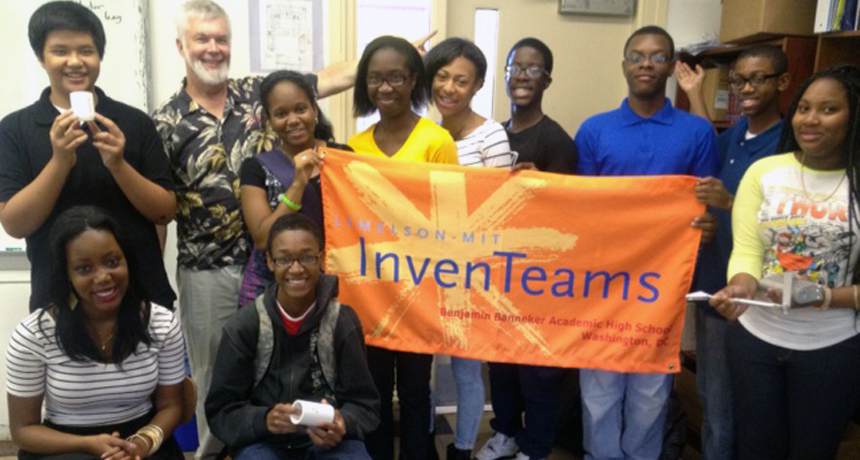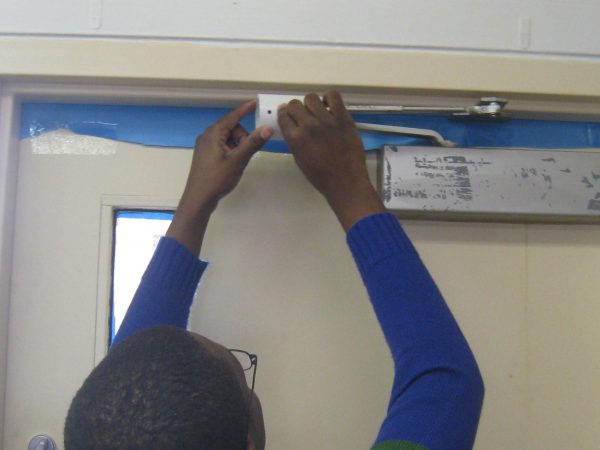Students invent safer school lock
Concerned about school shooters, Washington, D.C. students engineer a way to keep their classrooms safer

The Benjamin Banneker Academic High School Robotics Team poses with its InvenTeam banner.
John Mahoney/Benjamin Banneker Academic High School
The December 2012 shooting at former Sandy Hook Elementary School in Connecticut shocked and saddened the nation. But a group of high school students at Benjamin Banneker Academic High School also found inspiration from the tragedy. They want to make things safer. And this week they unveiled a technology that they said could help students if they were confronted with such an in-school threat. It’s a new door lock called Dead Stop.
The shooting at Sandy Hook “really devastated us,” says junior Deonte Antrum. “We wanted to invent something to prevent intruders coming in.”
Did you know that most of classroom doors lock only from the outside? That means they have to be kept unlocked during school hours. After all, if there’s a fire, you don’t want to find yourself locked in. But there are situations where being able to lock the door from the inside could be a good thing. For instance, what if someone dangerous started wandering the school halls?
The Benjamin Banneker teens knew they wanted to build something to keep a door closed if danger lurked. They weren’t initially sure how. So throughout the first day, “we were just looking all over the door, looking at what could stop it from opening,” recalls Anjreyev Harvey. She’s a junior who captains the school’s robotics team. Before long, they started fixating on the hinge. “We thought, whatever we do, it will have to be on the hinge, to stop it expanding.”

Their solution is to pin a cylinder of plastic pipe over the hinge of the automatic door closer. That closer is attached to the top of the door, and if its hinge can pivot, the door can’t open. The cost of the parts should cost $5 or less. It’s a do-it-yourself fix. And when they come up with a final design, they teens hope to make it available to everyone. Right now they’re working on other ideas to replace the pin.
The first idea had been to use a nail to lock the hinge closed. But that turned out to be a bad idea, notes freshman Dea-Damita Onyenobi. In one test, it “flew across the room.” But they are now considering other solutions and homing in on an even better approach. “If we’re going to have a magnet lock, it might collapse, and if we’re going to use a nail lock, it’s not strong enough,” says freshman Mark Miranda, the lead developer on the project. “I’m thinking about putting in a bolt.”
They’ll have lots of opportunities to get it right. The robotics team applied for a grant from the Lemelson-MIT InvenTeam to refine and patent their idea. And they won!
Explainer
What is a patent?
Benjamin Banneker Academic High School is a special place, with 440 students and an excellent academic reputation. The majority of its students go on to college.
“Some schools say that they are the Spartans or the Eagles, but our kids are the ‘Achievers,’” says mathematics teacher John Mahoney.
He started the school’s robotics club (which he heads) back in 2002. His motivation: “to develop the kids’ comfort and confidence with wrestling with complex problems.” Their very first year, Mahoney says “we built a 105 pound robot.” They even competed at the For Inspiration and Recognition of Science and Technology (FIRST) Robotics Competition in Richmond, Va. For now, they are focused on improving the new lock.
The students love the opportunity to invent. “I remember when I was very little, I used to see Dexter’s Laboratory,” says freshman Jed Delatorre. Since then, he has always wanted to build the kind of contraptions he saw Dexter build in the cartoon. “Everyday cartoons can inspire you to do amazing things,” he says. The students have ambitions to become zoologists, veterinarians, computer scientists and engineers. And with the money from InvenTeam and the power of science, Benjamin Banneker’s teens hope to find a low-cost way to keep students and teachers safer.
DEAD STOP A student from Benjamin Banneker Academic High School installs DeadStop on the inside of a door to keep it from being opened. Courtesy of Bethany Brookshire
Power Words
computer scientist A scientist who studies how computer systems work.
engineer A person who uses science to solve problems. As a verb, to engineer means to design a device, material or process that will solve some problem or unmet need.
patent A legal document that gives inventors control over how their inventions — including devices, machines, materials, processes and substances — are made, used and sold for a set period of time. Currently, this is 20 years from the date you first file for the patent. The U.S. government only grants patents to inventions shown to be unique.
robotics The study of how to design and develop robots.
veterinarian A person who treats disease in animals.
zoologist A scientist who studies animals and their habitats.